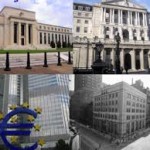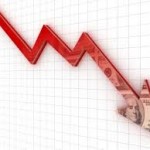The danger of eliminating cash

 In the early days of central banking, one primary objective of the new system was to take ownership of the public’s gold, so that in a crisis the public would be unable to withdraw it.
In the early days of central banking, one primary objective of the new system was to take ownership of the public’s gold, so that in a crisis the public would be unable to withdraw it.
Gold was to be replaced by fiat cash which could be issued by the central bank at will. This removed from the public the power to bring a bank down by withdrawing their property. A primary, if unspoken, objective of modern central banking is to do the same with fiat cash itself.
There are of course other reasons for this course of action. Governments insist that they need to be able to trace all private sector transactions to ensure that criminals do not pursue illegal activities outside the banking system, and that tax is not evaded. For the government, knowledge of everything individuals do is necessary control. However, in the monetary sense, anti-money laundering and tax evasion are not the principal concern. Central banks are fully aware that the financial system is fragile and could face a new crisis at any time. That’s why cash in their view must be phased out.
A gold run against a bank or banks, in the ordinary course of banking, is no longer a systemic threat, but the possibility that depositors might queue up to withdraw physical cash from a bank in which they have lost confidence is very real. Furthermore it is a public spectacle associated with monetary disorder of the most alarming sort. It is far better, from a central banker’s point of view, to only permit the withdrawal of a deposit to be matched by a redeposit in another bank. That way, a bank run can be hidden through the money markets, with or without the intervention of the central bank, and the deflationary effects of cash hoarding are avoided.
This is commonly understood by followers of monetary matters. What has not been addressed properly is how a cashless economy behaves in the event of a significant alteration in the public’s preferences for money relative to goods. Normally, there is a balance in these matters, with the large majority of consumers unconcerned about the objective exchange-value of their money. There are a number of factors that can change this complacent view, but the one that concerns us for the purpose of this article is the speed at which the relationship between the expansion of money and credit and the prices of goods and services can change.
There is no mechanical link between the two, but we can sensibly posit that the extra demand represented by an increase in the money quantity will eventually drive up prices, setting the conditions for a potential shift in public preferences for money, which would drive prices up even more. When the general public perceives that prices are rising and will continue to do so, people will buy in advance of their needs, increasing their preference for goods over holding money.
This is currently desired by central bankers wishing to stimulate demand, but they are under the illusion it is a controllable process. Furthermore, increases in the money quantity are being driven by factors not under the direct control of monetary authorities. Welfare states are themselves insolvent and require the issuance of money and low-interest credit to balance their books. Commercial banks can only continue in business if the purchasing power of money continues to fall, because their customers are over-indebted. Unless the expansion of the money quantity continues at an increasing rate, the whole financial system will most likely grind to a halt. It is now required of central banks to ensure the money quantity continues to expand sufficiently to prevent systemic failure.
It is therefore only a matter of time, so long as current monetary policies persist, before it dawns on the wider public what is happening to money. Preferences will then shift more definitely against holding money, radically altering all price relationships. If this leads into a hyperinflation of prices, which is the logical and unavoidable outcome, the speed at which money collapses will be governed in part by physical factors. In the case of Germany’s great inflation in the 1920s, the final collapse can be tied down to a period of six months or so, between May and November in 1923, after a last-ditch attempt to control monetary inflation failed.
The limiting factor in this case was the time taken to clear payments through the banking system, and when prices began to rise so rapidly that cheques lost significant value during the clearing and encashment process, the economy moved entirely to cash. When prices rose faster than cash could be printed, the limitation on the purchase of necessities then became one of cash availability.
It is in truth impossible to isolate all the factors involved, and the course of events during the destruction of a currency’s purchasing power is bound to vary from case to case. Today the situation is very different from the hyperinflations in Europe over ninety years ago. A society which uses electronic transfers spends bank deposits instantly. The merchant, who is subject to the same panic over the value of the payment received looks to dispose of his cash balances as rapidly as possible as well. In other words, the electronic transfer of money has the potential to facilitate a collapse in purchasing power at a rate that is far more rapid than previously experienced.
The most obvious delaying factor left becomes the speed with which the public realises that government money has no value at all. People are generally ignorant of monetary matters, and a majority of them have no alternative but to believe in their money, because without it they are reduced to barter. It is entirely human to wish these concerns away. For a minority of the population lucky enough to have a combination of wealth and foreign currency bank accounts the problem was not so great in the past, but the interconnectedness of the global monetary system suggests that all today’s fiat currencies face the same problem contemporaneously, and there is no refuge in foreign currency.
These concerns have encouraged the development of alternative solutions, such as our own Bitgold/GoldMoney payment and storage facility, which will allow both consumers and producers to reduce their exposure to the banking system and continue to trade. There are also private currency alternatives such as bitcoin. Whether or not alternative currencies have a future monetary role for ordinary people at this stage looks unlikely, primarily because they are less stable than government currencies; however that might change in the future. They represent a work-in-progress that has the power to undermine the state monopoly on money, not least because they lie outside a government’s ability to manage capital controls directed through the banks.
What fascinates many of those with an understanding of anticipatory private sector solutions, is the potential for triggering a seismic change in the money used today. They have the ultimate potential to free commerce from the whole concept of a state-directed monetary policy. Rapidly developing technological solutions are therefore another factor that could accelerate the public rejection of government money and the state-licensed banking system, simply by offering a practical alternative to a debasing currency. With the progress being made to eliminate cash and the private sector’s ability to develop an alternative financial system in advance, if the collapse of government money comes, it could be very swift indeed.
1.Von Mises, The Theory of Money and Credit, (Yale University Press 1953) page 254.
By Alasdair Macleod, www.goldmoney.com
Find more: Contributing Authors





























